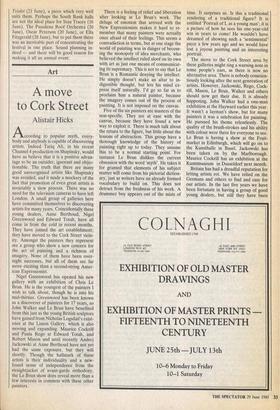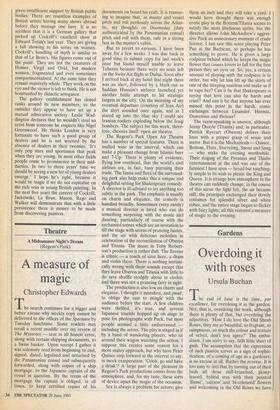Art
A move to Cork Street
Alistair Hicks
According to popular myth, every- body and anybody is capable of discovering artists. Indeed Tariq Ali, in his recent Channel 4 production on Shapinsky, would have us believe that it is a positive advan- tage to be an outsider, ignorant and objec- tionable. The truth that there are many good unrecognised artists like Shapinsky was avoided, and it made a mockery of the fact that promotion of even great artists is invariably a slow process. There was no need for the television cameras to have left London. A small group of galleries here have committed themselves to discovering artists for many years. Coincidentally these young dealers, Anne Berthoud, Nigel Greenwood and Edward Totah, have all come in from the cold in recent months. They have joined the art establishment; they have moved to the Cork Street vicin- ity. Amongst the painters they represent are a group who show a new concern for the act of painting and a richness of imagery. None of them have been over- night successes, but all of them are far more exciting than a second-string Amer- ican Expressionist.
Nigel Greenwood has opened his new gallery with an exhibition of Chris Le Brun. He is the youngest of the painters I wish to talk about, though he is into his mid-thirties. Greenwood has been known as a discoverer of painters for 17 years, so John Walker and Le Brun have benefited from this just as the young British sculptors have gained from Nicholas Logsdail's exist- ence at the Lisson Gallery, which is also moving and expanding. Maurice Cockrill and Paula Rego at Edward Totah, and Robert Mason and until recently Andrej Jackowski at Anne Berthoud have not yet had the same exposure, but they will shortly. Though the hallmark of these artists is their individuality and a new- found sense of independence from the straightjacket of avant-garde orthodoxy, the Le Brun show does reveal more than a few interests in common with these other painters. There is a feeling of relief and liberation after looking at Le Brun's work. The deluge of emotion that arrived with the New Expressionists makes it hard to re- member that many painters were actually once afraid of their feelings. This seems a contradiction in terms, but at one stage the world of painting was in danger of becom- ing the monopoly of idea merchants, who believed the intellect ruled aloof on its own with art as just one means of communicat- ing its supremacy. This is not to say that Le Brun is a Romantic denying the intellect. He simply doesn't make an altar to in- digestible thought, but lets his mind ex- press itself naturally. I'd go so far as to proclaim him a natural painter, because the imagery comes out of the process of painting. It is not imposed on the canvas.
Five of the six painters are masters of the non-specific. They are at ease with the canvas, because they have found a new way to exploit it. There is much talk about the return to the figure, but little about the lessons of abstraction. This group have a thorough knowledge of the history of painting right up to today. They assume this to be a normal starting point. For instance Le Brun dislikes the current obsession with the word 'myth'. He takes it for granted that elements of his subject matter will come from his pictorial diction- ary, just as writers have an already formed vocabulary to build on. This does not detract from the freshness of his work. A drummer boy appears out of the mists of time. It surprises us. Is this a traditional' rendering of a traditional figure? It is entitled 'Portrait of L as a young man'; it is, a picture of how he sees his one-year-old son in years to come! He wouldn't have, dreamed of showing such a 'sentimental" piece a few years ago and we would have lost a joyous painting and an interesting portrait.
The move to the Cork Street area by these galleries might ring a warning note in some people's ears, as there is now no alternative area. There is nobody conscien- tiously looking after the next generation of artists. However, Jackowski, Rego, Cock- rill, Mason, Le Brun, Walker and others should now get their due. It is already happening. John Walker had a one-man exhibition at the Hayward earlier this year. It wasn't a layman's show, but for many painters it was a celebration for painting. He pursued his theme relentlessly. The quality of the brush-strokes and his ability with colour were there for everyone to see. Le Brun is having a show at the Fruit- market in Edinburgh, which will go on to the Kunsthalle in Basel. Jackowski has been taken on by the Marlborough. Maurice Cockrill has an exhibition at the Kunstmuseum in Dusseldorf next month.
Britain has had a dreadful reputation for letting artists rot. We have relied on the Germans and others to find and care for our artists. In the last five years we have been fortunate in having a group of good young dealers, but still they have been
given insufficient support by British public bodies. There are countless examples of British artists having many shows abroad before they manage one here. It is no accident that it is a German gallery that picked up Cockrill's excellent show at Edward Totah's last year. They are giving a full showing to his series on women. Cockrill's handling of myth is similar to that of Le Brun's. His figures come out of the paint. They are not the creatures of Homer, Virgil and Ovid, but modern women, fragmented and even sometimes compartmentalised. At the same time they remain massively whole. They work on the eye and the viewer is left to think. He is not bombarded by didactic arrogance.
The gallery establishment has closed ranks around its new members; to the outsider they appear to have set up a mutual admiration society. Leslie Wad- dington declares that he wouldn't steal an artist from someone he respects like Nigel Greenwood. He thinks London is very fortunate to have such a good group of dealers and he is not worried by the absence of dealers in their twenties. 'It's only pop stars and sportsmen that peak when they are young. In most other fields people come to prominence in their mid- thirties. In two to three years' time we should be seeing a new lot of young dealers emerge.' I hope he's right, because it would be tragic if we do not capitalise on the rich vein in young British painting. In the next five years the careers of Cockrill, Jackowski, Le Brun, Mason, Rego and Walker will demonstrate that with a little persistence there is money to be made from discovering painters.



























































 Previous page
Previous page